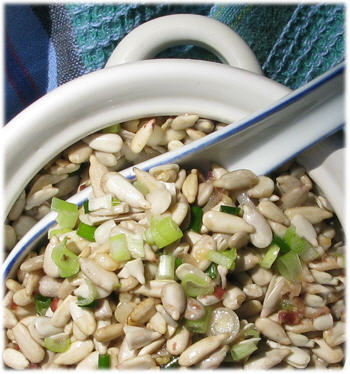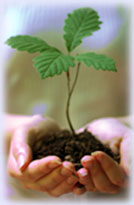 | |
|
Our lives,
so seemingly small, ripple out to the whole universe as tiny whispers like the sounds of butterfly wings, and the clear voice of the living truth. -J.L.D. |

Ten years ago when I dreamed of the possibility of living on raw foods, I used to imagine myself eating a bowlful of vibrant, health-giving sunflower seeds every day. It was always summertime, and I ate them with juicy diced apples—and I was always wearing a white linen shirt.
 This filling and protein-rich dish (35 grams per cup!) has become a part of the manifestation of this dream.
This filling and protein-rich dish (35 grams per cup!) has become a part of the manifestation of this dream.The salty miso with the mild tasting sunflower seeds makes a delightful combination, and the lemon juice, green onion and ginger add both tang and kick. This dish is simple in preparation and is most appreciated on a hot summer day when working in the kitchen might be the last place I'd want to be! Ingredients (Serves 2-4): 1 cup dry, raw, sunflower seeds 3 cups pure water 3 tablespoons chives or green onions, minced 1 tablespoon favorite miso (we like South River Azuki) 2 teaspoons Spectrum Walnut oil 2 teaspoons finely grated ginger Juice of 1/2-1 lemon Optional: 1 small clove garlic, pressed Directions: Soak sunflower seeds in a one quart mason glass jar, filled with pure water for 6-8 hours. Remove skins (directions follow) and drain. Add miso. Mince green onions and finely grate ginger and add to seeds. Add oil and lemon, and mix ingredients well. Serve immediately as is, or add to your favorite salads, or sprinkle on top of veggies. Cover any leftovers and store in fridge. Tip: Sunflower skins oxidize, so the color can change after several hours. Lemon juice helps retard discoloration. Removing the skins helps too. Seeds are still fine to eat, but don't look as tasty. We find that removing the skins improves the overall texture of the dish.  To remove sunflower seed skins: takes 3 minutes:
To remove sunflower seed skins: takes 3 minutes:Pour sunflower seeds with soak water into a large bowl. Fill with additional water. Rub submerged seeds briskly between palms 5-6 times. Pour water and skins that float through a strainer, retaining the bulk of the seeds in the bowl. (I hold the bowl in my right hand, and the strainer in my left hand as I pour. This took me a few times before I got the hang of it.) Refill bowl with water, and repeat two times. Drain well before adding other ingredients. A Little Story: One Meal A Day We experimented for five days this week with having only one meal a day that was eaten—chewed. The other meals were liquefied—smoothies, soups, or juice. We lost a couple of pounds, felt lighter, and had more mental focus. Having one eaten meal a day brought an unexpected surprise: we found that we looked forward to that meal all day long, and when it came we appreciated it more than ever, and spent more time savoring it. Intuitive knowingness about what our bodies needed to eat came through with stunning clarity. Mindfulness was enhanced as we sat at the table, taking in the food as a sacred gift. The preparation of the one meal became a pleasure instead of feeling like it was yet another meal we had to make. And an added benefit was that the blended meals helped take some of the load off the digestive system. We felt nourished and satisfied. This experiment was a simple example of the art of intuitive eating and living a love-based life that came by listening to the inner guidance on how and what to eat. These simple acts let love be love within us, from our bones to the skin, and radiated from our hearts to the world.  |









